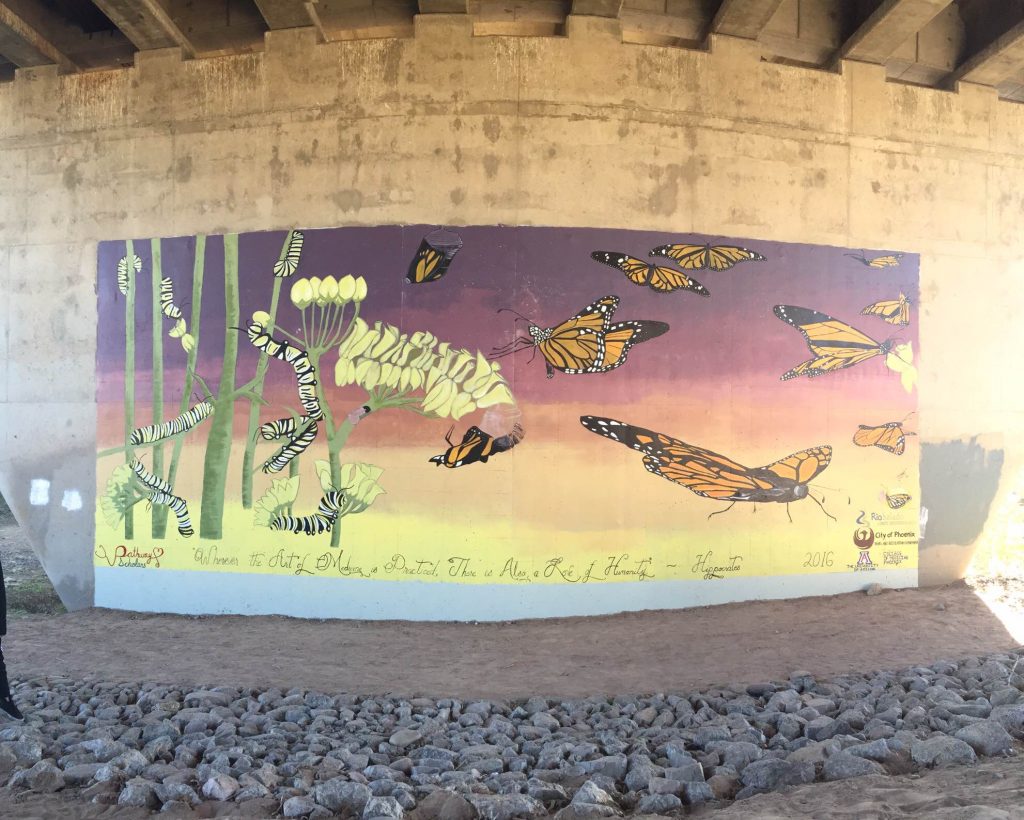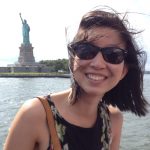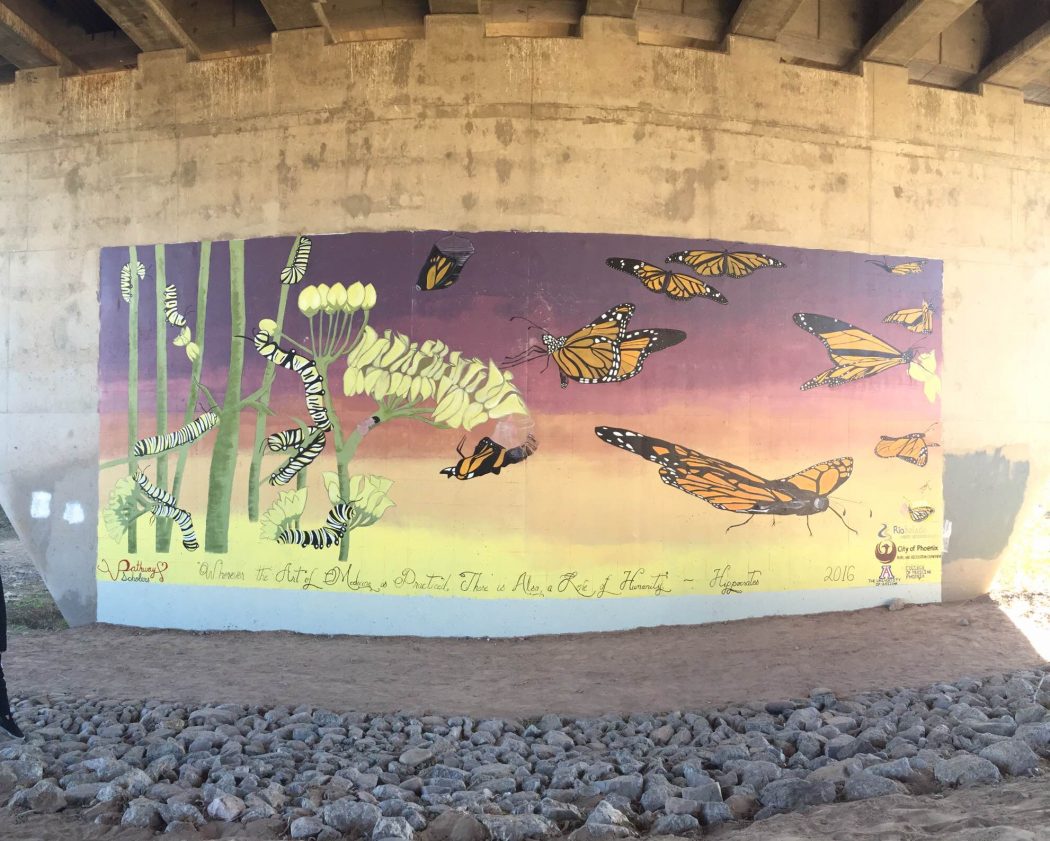In late December, after the last exam of the semester was completed and all assignments were submitted, students eagerly left campus with plans for vacation, holiday extravaganzas, vegging out, or more studying. However, Monica Lopez, MS1 and Pathway Alumna, was thinking about the logistics of the Pathway program mural that she and other volunteers would paint over winter break. Plans for the mural began months ago, and Monica is the artist who created the monarch butterfly design and coordinated the project with the City of Phoenix Parks and Recreation Department, Rio Salado Habitat Restoration Area, and the Southwest Monarch Study. The painting of the mural took ten days to complete with the help of 24 volunteers who worked more than 50 hours. It is located on the north side of the Central Avenue Bridge and can be accessed via a short walk through the Rio Salado Habitat Restoration Area (on Central Avenue just south of the Maricopa Freeway).
 I had the privilege to help with this project for a few days and watch it develop. Everyone who volunteered their time and efforts were incredibly hardworking, inspired by this work of art and its creator. Monica arrived early every morning (often with coffee and bagels for everyone), worked through some of the coldest days of winter, hauled materials and built scaffolds, and cleaned up everything often after sunset with the determination to finish the mural by New Year’s Day. After its completion, Monica discussed some of the background for this piece of art with me in an interview:
I had the privilege to help with this project for a few days and watch it develop. Everyone who volunteered their time and efforts were incredibly hardworking, inspired by this work of art and its creator. Monica arrived early every morning (often with coffee and bagels for everyone), worked through some of the coldest days of winter, hauled materials and built scaffolds, and cleaned up everything often after sunset with the determination to finish the mural by New Year’s Day. After its completion, Monica discussed some of the background for this piece of art with me in an interview:
Aishan: Congratulations on this huge accomplishment! Tell us about the origin of this mural—how were you inspired to undertake this project and bring this work of art to UA COM-P and the local Phoenix community?
Monica: When I was a Pathway scholar, the curriculum included a community project that we as students had to come up with as a cohort. One day, jogging in this area, I saw several murals along the walls of the underpass and thought it would be a great way to share our great program with the community while doing a team-building activity with our group and, at the same time, helping restore this amazing area for the community and their families.
Aishan: What processes did you have to go through in order to turn this idea into reality?
Monica: The process started as an idea I got this one day I went jogging, and it took me about one year to bring it to fruition. First, I contacted a member of our local Audubon. They gave me a contact to another source, which referred me to Ranger Koy who was key to getting the proper approvals to paint on the wall that I had chosen. Several meetings later with Rio Salado Habitat Restoration Area, City of Phoenix Park and Recreation Department, Southwest Monarch Study, Pathway Scholars Program, and UA COM-P, we had all the approvals required. Then came the design, a lot of reading, and YouTube videos on how to create a mural and the best conditions to paint, how to prepare a wall, what type of paint is the best, measuring the wall, assessing the area for safety, and proper coordination with the rangers at Rio Salado to make sure everyone would be safe on ground that was safe and properly level to place a scaffold to paint on; coordination of volunteers and daily updates to the proper people; and sufficient fundraising for all the material.
Aishan: Reflecting on this experience, what were some of the best things, worst things, challenges, and/or silly moments that are meaningful to you?
Monica: It was challenging to be going through Clinical Anatomy, MBLD, NMS, NLS, Doctoring, SP, and several other projects I was currently working on while trying to put a mural of this size (16 ft X 40 ft) together to be completed within a two-week period. I spoke to a local muralist, and he said it would be challenging to accomplish it in the time given. But it was rewarding see it done in a little less than two weeks. Spending time with the other volunteers was the most rewarding. It was never about creating the perfect mural; it was about engaging others in this mission of creating awareness about our school and our very own Pathway Scholars Program, which will serve to increase diversity in our school. It was about sending a message to our community of this goal and cultivating the idea of a career in medicine in many of our youth that come to the Rio to spend time with their family.
Aishan: In your interpretation of the mural, you emphasize that the metamorphosis process of the butterfly represents transformation and that the journey of the monarchs, in particular, parallels the obstacles that have been overcome in order to achieve the dream of training to become a physician. Can you share with us your path to medical school and what the Pathways Program means to you?
Monica: I have had a unique path to medicine, just like many of our classmates. I was born in Mexico. While in Mexico, at the age of six, I went to school and worked after school. I took care of myself and looked after my sister. I cooked and cleaned and washed clothes by hand on a washboard. My mom at that time worked in agriculture in the US. Neighbors looked after us when my mom was gone. We only saw her once or twice a year…until she made the decision to bring us to Arizona with her. The only problem with this was that she brought me illegally—my sister is a citizen (part of another crazy story!). This fact shaped the next few years of my life until 2012 when I was able to get residency status.
While I lived in Mexico in one of the poorest, underserved areas, I did not know I wanted to be a doctor, but I did know I wanted to help carry our family forward. My mom engrained in my head that in order to do that, I needed to have a career. But never did I reach for the sky and say I want to be a doctor. Mentors in my life slowly helped mold this idea in me. I started with biomedical engineering. I received my degree from ASU. However, I knew that I would not be able to work with this degree because I was still illegal and unable to pursue any dream. Still, I always said to myself, “I can be labeled illegal and be taken away from this country that I love, but they will never be able to take my education away.” So this was the thought that pushed me forward for many years.
I did many things during the time until I could apply to medical school to get ready for it, but nothing could have prepared me better for medical school than the Pathway Scholars Program after being off for six years. And so, for this I am eternally grateful for the PSP, and the mural was my personal way of showing my appreciation and desire for the program to continue to help many more students like myself who now desire nothing more than to be a doctor and help the people who need it the most.
Aishan: Similarly, what transformations do you envision or hope to inspire in the community with this mural and/or your future career?
Monica: At the very least, I know for a fact that this mural has inspired others to care about their community. While working on the mural, several people approached me expressing their desire to do something similar and asked for the proper contacts. I hope that this mural gets kids thinking about their future.
Aishan: In what other ways have you used art in the past, and how did you become interested in art?
Monica: In Mexico, the curriculum teaches kids about handcrafts. Then I came here to Arizona, and they cultured my love for art even further with painting, drawing, sculpture, glasswork, etc. My teachers always chose my artwork to be put on display and entered into different contests, but I never thought anything of it. It has just always been a part of my life, and I use it to express myself, especially when I cannot find the right words.
Aishan: Do you have plans for future public art projects in the future, or what other outreach activities/methods will there be for the Pathways Program?
Monica: At the moment I have no plans for future public art projects. But they usually come out of the blue to me, so don’t be surprised if in the future I ask for everyone’s help on another project!
Aishan: Thank you so much for spending your holiday break to bring this mural to this community, and for this interview! Any final comments?
Monica: I am very blessed and grateful to have had the help I received from students and staff for this project I envisioned one year ago, and thanks to all of you, it came to reality this past December 31, 2015.
The Monarch will symbolize “the butterfly effect.” It’s important for the community to know that small changes at any point in time ultimately lead to great changes down the road, which is what the Pathway Scholars Program is about. We must not forget that the choices we make in life will impact our community and immediate family. Our struggles are their struggles.
The butterflies also represent migration. Our community is composed of many immigrants who will empathize with the struggles this brings to the family as a whole.
Furthermore, monarchs represent transformation, which signifies each and every member of the community undergoing daily transformations due to bio-psycho-social and environmental factors. Each and every one of us in the community has the potential to have an effect on those around us; we must NOT take this for granted.
These one-of-a kind, migrating creatures travel great distances to achieve their goal in life. Despite everything against them and their fragile anatomy, they never give up because of their fierce nature. This will represent overcoming obstacles, just like how we have faced many obstacles but remained focused on the final goal and overcame every one of them to get to medical school. We will help and advocate for others like us, in our community, to get there, too, if they so choose.
We are all transforming before each other’s eyes and soon will migrate, in a few years, to our final destinations. In a deeper, philosophical notion, we are achieving our moms and dads’ goals for us, which they have started and cultivated in us along with the belief in the importance of an education—just like the parent monarchs start the journey in Canada and their progeny finish it in Mexico. I think the community will relate to all these themes.
The mural, going from left to right, depicts a timeline of events, with the transformation happening in the middle of the mural. The left side is very busy. It represents several things. First, there are 10 caterpillars representing the 10 current Pathway Scholars. The 10 caterpillars are embedded in a bed of desert milkweed just like the one found in the Monarch Way Station at the Rio Salado Park. There are two male caterpillars and eight females to match the gender distribution of the current Pathway Scholars class of 2016. The caterpillars are in different developmental states and anatomical positions representing the different personalities, mental, physical, and emotional states that the current scholars (and our community members) might find themselves in. There are three male butterflies and seven female butterflies that represent the alumni Pathway Scholars that have completed the initial transformation into the next phase of their lives (medical school).
The entire mural is a community. The community is affected by everything surrounding it. The milkweed is a source of food, energy, and, safe housing for the current generation and the ones to come. It must be treasured and sustained in order for the members living in it to survive and prosper. All parts of the community—from the animate to the inanimate—are essential for the sustainability of the community as a whole.
The middle of the mural represents the transformation that is taking place for the current generation (and community) of Pathway Scholars as well as the stage that Pathways alumni found themselves in and continue to be in.
Finally, the right side of the mural is cleaner and less busy. This represents the clear path, “leveled field,” that the Pathway Scholars Program has placed us in for our future in medical school. It represents hope. It represents overcoming those previous obstacles.
The lines in motion represent WIND.
The wind represents more obstacles in our path that help keep us grounded but at the same time remind us that we must keep growing and learning and overcoming obstacles that will in the end give us more character. In other words, “What doesn’t kill us, makes us stronger.”
The wavy lines also represent the different PATHWAYS we each must take in our careers and life without forgetting about our roots, mission, vision, and values and how we must instill those ideals to future generations.
We are clearing the path for the next generations to come in our community so that they can have more opportunities with all the advantages and none of the disadvantages we faced. We hope that they can be in the same playing field from the beginning, and they can concentrate on their ultimate goals.
1. Ethics Statement. Council of Medical Specialty Societies. http://cmss.org/policies-positions/ethics-statement/ Accessed October 28, 2015.
2. Principles of Medical Ethics. American Medical Association. http://www.ama-assn.org/ama/pub/physician-resources/medical-ethics/code-medical-ethics/principles-medical-ethics.page Accessed October 28, 2015.
3. Laveist T, Gaskin D, Richard P. Estimating the economic burden of racial health inequalities in the United States. International Journal of Health Services. 2011;41:231-238.
4. Joint Center for Political and Economic Studies. The economic burden of health inequalities in the United States. 2009. Washington, DC.
*Foundational ethical concepts were researched in Principles of Health Care Ethics, Second Edition Edited by R.E. Ashcroft, A. Dawson, H. Draper and J.R. McMillan © 2007 John Wiley & Sons, Ltd
 Aishan Shi is a first-year medical student and second-year MBA student at UA COM-Phoenix. She graduated in 2013 from The University of Arizona with bachelor’s degrees in biochemistry, molecular and cellular biology, and English. Her interests include medical humanities, structural biology, Shakespeare, stuff in the realm of postmodernism, and cartoons. She aims to bring all these interests together in medicine. To contact Aishan, please email her at ashi1[at]email.arizona.edu.
Aishan Shi is a first-year medical student and second-year MBA student at UA COM-Phoenix. She graduated in 2013 from The University of Arizona with bachelor’s degrees in biochemistry, molecular and cellular biology, and English. Her interests include medical humanities, structural biology, Shakespeare, stuff in the realm of postmodernism, and cartoons. She aims to bring all these interests together in medicine. To contact Aishan, please email her at ashi1[at]email.arizona.edu.

Monica Lopez is an MS1 and Pathway Scholars Program alumna. She obtained her bachelor’s degree in biomedical engineering from ASU. To contact Monica, please email her at mpgomezlopez[at]email.arizona.edu.
The Differential is a platform for UA COM-P medical students that aims to educate, inform and enlighten our community through collaborative dialogue and communication.

